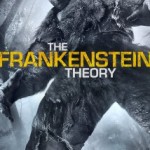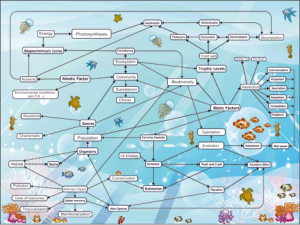This week’s mind map began with an image choice that was — excuse me — a “no brainer” (you’re welcome, punsters; and I’m sorry, punsters). The image of the neuron — with all its accompanying transmission components — seemed well suited to my attempts to show connections and flows of information through the Popplets. Clearly, I love brain-based metaphors. But I digress…
The connections we discussed in class regarding Ecosystems and Brain Chemistry revealed several assumptions I had been working through that may have falsely equated the two on some levels. Therefore, even though I’ve positioned the two sets of readings close together to signify connections, thanks to comments made by Daniel in our FrankenTheory Activity about nodes and neurons and his comments during class about seeing the biosystem as the core of a larger ecological system, I’m also seeing the “gaps.” Dr. Julia explained such gap perception in terms of distributed cognition allows us to use the neurology material as a metaphor for our networked OoSs, but we must be mindful of the limitations — thus, the need for a FrankenTheory.
So, the links I drew in the Mind Map between Bateson in particular — thinking as I was of his reference to Korzybski that “the map is not the territory” (455) — seemed to fit my emerging understanding of the metaphor’s possibilities and limits. An example of my thinking on this showed up in my notes:
“Also opens up the chance to speak about affordances if we link this to an ecology. Is it the same, though? Can we talk about the neuronal network as an ecosystem? Perhaps not, although pointing to the ecology as a way to extend this metaphor, talk about the connections to other, non-self enclosed networks might be a way around this.”
 Other unexpected connections emerged as I looked over my Popplet’s existing links. For example, the explanation of neurotransmitters reminded me (and Leslie) of the “How It Works” bus processes, and the potential for multiple-directionalized connections and transmissions.
Other unexpected connections emerged as I looked over my Popplet’s existing links. For example, the explanation of neurotransmitters reminded me (and Leslie) of the “How It Works” bus processes, and the potential for multiple-directionalized connections and transmissions.
Still another connection with the bio text took me back to Guattari and Bateson on subjectivity, specifically to Guattari’s politicized definition of ecologies in that we must be theorize our own places in this ecosystem as “in the weeds,” not a god’s-eye view. So, out shoots a tendril to Guatteri and to Bateson. From there, I return to Distributed Cognition, which adds a wider, ecosystem-like layer beyond the neurobiology “core” (thanks to Daniel for that term) – and provides a systems framework for it to place the whole shebang into a cultural perspective, opening up a possible “node” of connection with my OoS of composition MOOCs. In fact, for my 3rd Case Study, I feel like I must combine the threads of both neurobiology AND ecosystem theory (especially Bateson) in order to do it justice.
Thus do I come to my wrap-up for this week’s Mind Map choices: the ecosystem / neurobiology connections illustrate how even a metaphor can function as a means to open new ways to discuss something still “new and strange” like a MOOC, hopefully in ways that will allow for the different space of a “classroom” network and all of its potential pathways.



